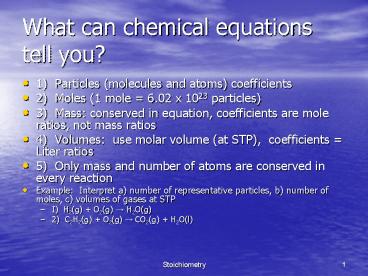What can chemical equations tell you
1 / 13
Title:
What can chemical equations tell you
Description:
Stoichiometry. 1. What can chemical equations tell you? ... Calculated from reaction (stoichiometry) Represents maximum amount formed from reactants ... –
Number of Views:47
Avg rating:3.0/5.0
Title: What can chemical equations tell you
1
What can chemical equations tell you?
- 1) Particles (molecules and atoms) coefficients
- 2) Moles (1 mole 6.02 x 1023 particles)
- 3) Mass conserved in equation, coefficients are
mole ratios, not mass ratios - 4) Volumes use molar volume (at STP),
coefficients Liter ratios - 5) Only mass and number of atoms are conserved
in every reaction - Example Interpret a) number of representative
particles, b) number of moles, c) volumes of
gases at STP - I) H2(g) O2(g) ? H2O(g)
- 2) C2H2(g) O2(g) ? CO2(g) H2O(l)
2
Mole-Mole Calculations
- Can determine amount of product, amount of
reactant with another reactant, amount of product
from amount of reactant - For easy calculations (do in head, think)
- Harder use ratios
- Starting quantity, multiply by ratio, think
what goes on top? bottom? - Practice
- Al O2 ? Al2O3
- 14.8 mol Al how much O2 reacts?
- 3.7 mol Al2O3 from how much Al?
3
Mass to Mass calculations
- Cannot measure moles in lab, Must convert from
moles toMASS (grams) - Setup road map (Grams, Moles, Moles, Grams) Other
calculations - Mole to mole
- Mole to mass, mass to mole
- Example
- CaC2 2H2O ? C2H2 Ca(OH) 2
- If you have 49.0 g H2O, how many moles of CaC2
will combine? - If you have 5.00 g of CaC2, how many grams of
C2H2 are produced?
4
Other Calculations
- Mass to mole to particles (atoms, molecules,
formula units) - Example
- 2H2O ? 2H2 O2
- 29.2 grams of water produces how many molecules
of oxygen? - Volumes using 22.4 L/mol at STP
- Example
- 2C2H2 5O2 yields 4CO2 2H2O
- With 3 moles of C2H2, how many Liters of CO2
formed at STP?
5
Identifying the Limiting Reactant
- Recipes review limiting reactant
- Chemistry LR
- Reactant that is in short supply
- Determines the amount of product that can be
formed in a reaction - Excess reagent
- Not completely used up
- Determine with LR how much gets used and what is
left over - Examples
- Must determine how much of reactant goes with
other reactant - 2 Na Cl2 ? 2 NaCl
- 6.70 mol Na with 3.20 mol
6
Calculating Theoretical and Percent Yield
- Theoretical yield
- Calculated from reaction (stoichiometry)
- Represents maximum amount formed from reactants
- Actual yield
- Determined from experiment
- Given in a problem, or done in the lab
- Percent Yield
- Ratio of actual to theoretical
- Actual/theoretical x 100
- Should not be gt100 - what are some reasons why
- Usually lt100 - what are some reasons why
7
Examples
- CaCO3 ? CaO CO2
- If the theoretical yield of CaO is 13.9 grams,
and the actual yield is 13.1 grams, what is the
percent yield? - 2Al 3CuSO4 ? Al2 (SO4)3 3Cu
- If 1.87 grams of Al reacts with excess CuSO4, how
much copper is produced? - Calculate the percent yield if 4.65 of copper is
actually produced.
8
END
9
Calculations with Nonchemical Reactions
- Recipes Cooking, Baking
- Grams to Moles Masses of foods to amounts
(cups, tsp, tbsp) - Limiting Reactants
- Excess Reactants
- Percent Yield
10
Determining Avogadros Number
- Website
11
Labs
- Finish Hollow Penny (answer all questions)
- Setup Quantitative Analysis A/W 12
- Complete Types of Reactions A/W 11
12
Lab Quantitative Analysis A/W 12
- Objectives
- Measure number of moles of iron consumed and
copper produced in a reaction - Determine the coefficients of the balanced
chemical reaction - Hypothesis
- Write the balanced equation for the reaction of
iron metal and copper(II)chloride - Identify the type of reaction
- Predict observations for the reaction
- Techniques
- Decanting
- Questions (after Day 2) No Going Further
13
Lab Types of Chemical Reactions A/W 11
- Objectives
- Carry out several chemical reactions
- Write balanced chemical equations
- Techniques
- Burning Splint tests
- Burning vs. Glowing
- Safety GG, Acid
- Questions Just 1-5































